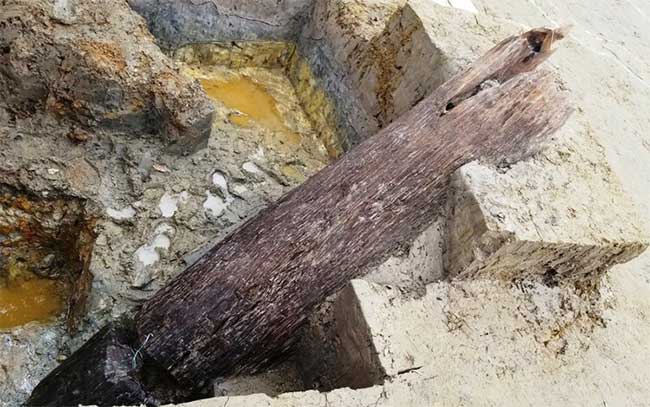Cao Quy pile pile opens a new research direction
Scientists believe that the discovery of the Cao Quy pile pit opens a new research direction on the Bach Dang Giang campaign, which may change the previous perception.
In the afternoon of December 20, an expert delegation of the Institute of Archeology, Historical Society and Vietnam Institute of Geology and leaders of Hai Phong city field in the pile site were excavated on Cao Quy field, Lien Khe commune. , Thuy Nguyen district.

A ironwood pole of 50cm diameter was discovered in a 45-degree inclined position.(Photo: Giang Chinh).
The scientists determined that this was a large and important pile-yard , related to the Bach Bang Giang campaign against the Yuan Mong invaders of the Tran people in 1288, led by Hung Dao Vuong Tran Quoc Tuan.
The pile ground is built by Tran Quoc Tuan in the bed of Da Bac river, at the junction leading to the creek connecting to Gia river, to the mouth of Bach Dang river. Over nearly 1,000 years, alluvial deposits, the flow changed, especially the impact of humans, so the river bed was narrowed and the old pile field now became part of a rich field.
In addition to ironwood stakes, many stakes are made of chrysanthemum and wood . The longest pile is nearly 5 m, shorter than 2 m; Large diameter of 0.5 m, small of 0.2 m. All piles are much better preserved than piles at the Quang Yen pile site (Quang Ninh).
However, archaeologists have not been able to explain how the pile is driven down because the excavation results show that many of the piles are flat.
History professor Le Van Lan said that the Cao Quy pile was discovered, showing that the victory of the Tran army and people in 1288 was "Operation Bach Dang Giang" rather than "Battle of Bach Dang Giang" as per the long-term perception. .
The campaign is divided into three phases. Phase 1 is intercepted to consume enemy life force. Phase 2 was to prevent the enemy from taking a shortcut from the junction of the Da Bach River, turning into a creek leading to the Gia River, connecting to the mouth of the Bach Dang River. Phase 3 was the decisive battle to win the Bach Dang River.

3 excavation pits at Cao Quy pile ground, Lien Khe commune, Thuy Nguyen district (Hai Phong).(Photo: Giang Chinh).
Cao Quy pile pile is in phase 2 of the Bach Dang Giang campaign in 1288. In order to prevent the invaders from entering Gia river, to keep the secret of the arranged battlefield on the Bach Dang river, Tran Hung Dao established a pile ground. Kneel
"In order to have a more general and objective view of the Bach Dang Giang campaign, we must study stages 1 and 2," said Mr. Le Van Lan.
Sharing the same opinion with Professor Lan about the importance of Cao Quy pile pile, Prof. Vu Minh Giang, Vice President of Vietnam Association of Historical Sciences, said that the discovery of Cao Quy pile pile opens a new research direction on the battlefield. Bach Dang Giang translation. It makes the researchers unable to conclude the battle on Quang Yen (Quang Ninh) or Thuy Nguyen (Hai Phong) is important.
Earlier, on December 18, a part of ironwood pile was discovered under mud in three holes in Cao Quy field, Lien Khe commune, Thuy Nguyen district. The piles are driven to a depth of 2.5 m, with a hooked end to place the zipper or tenon in the middle of the body. Each pile has a diameter of 20-50 cm, buried 5-7 m apart. Two samples of piles were assessed by radioactive isotope method Carbon 14 to give results dating from 1270 to 1430.
The third resistance against Nguyen Mong, the Tran army under the command of Hung Dao King Tran Quoc Tuan won. The Dai Viet Book of Historical Records, which chronicles the most prominent battle of Tran Quoc Tuan as Marshal as follows:
"In March, 8 (1288), the Yuan army at Bach Dang river to catch Truong Van Ho's salaries but did not meet. Hung Dao Vuong defeated them. Earlier, Wang had driven a stake in the Bach Dang river, covered with grass, on that day, on the day of high tide, Wang let the troops fight and pretended to lose, the enemy chased, our troops tried to fight back. Originally drowning untold, river water is so bloodshot ".
- Tran pile found nearly thousand years old
- Intelligent hydraulic pile presses are highly effective
- Tran pile found nearly thousand years old
- Pile prehistoric houses around the Alps - Austria's world cultural heritage
- How to determine the direction by the Moon
- How to determine simple directions by sun and experience
- Why do storms often follow the West-North direction?
- New way to fight malaria
- More opportunities for cancer patients
- How to determine the direction only through a puddle
- 'Strange' path of storm No. 4
- Build human parts with ... printers!
- The secret of the dog's tail waving direction
 'Fine laughs' - Scary and painful torture in ancient times
'Fine laughs' - Scary and painful torture in ancient times The sequence of numbers 142857 of the Egyptian pyramids is known as the strangest number in the world - Why?
The sequence of numbers 142857 of the Egyptian pyramids is known as the strangest number in the world - Why? History of the iron
History of the iron What is alum?
What is alum?